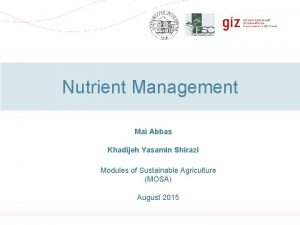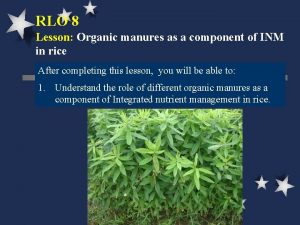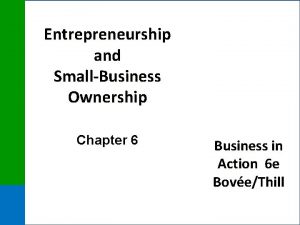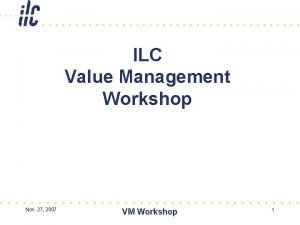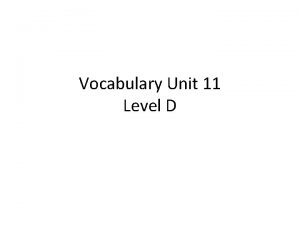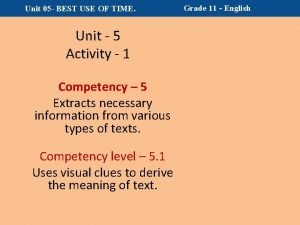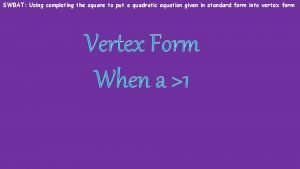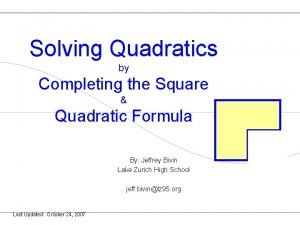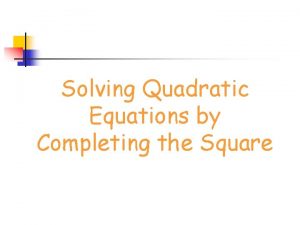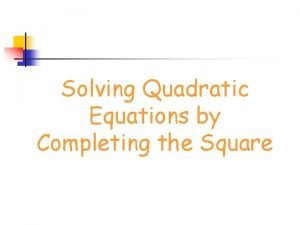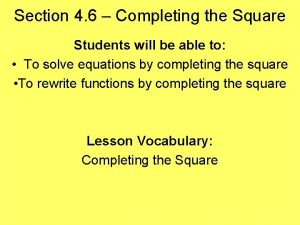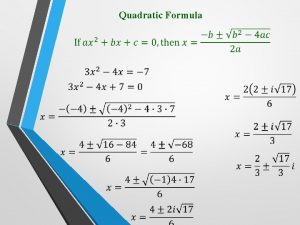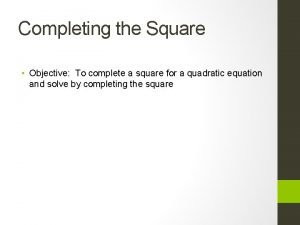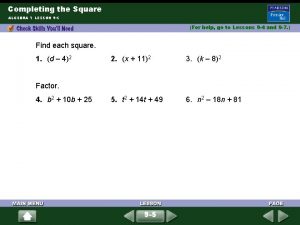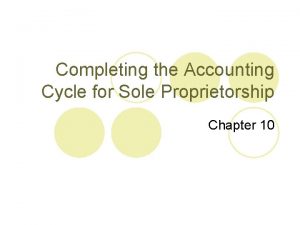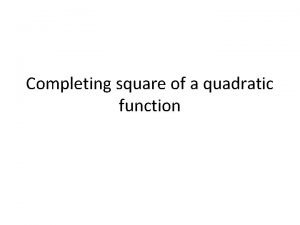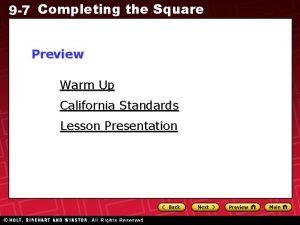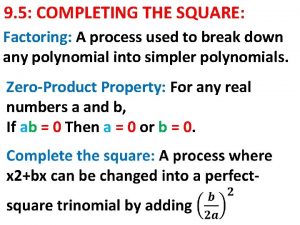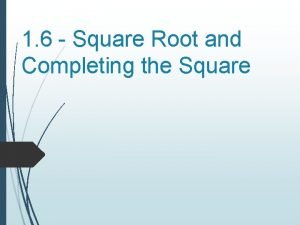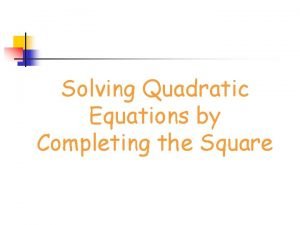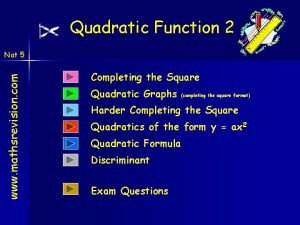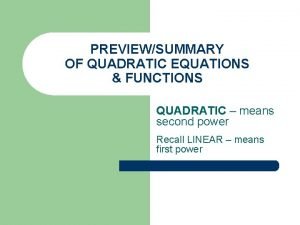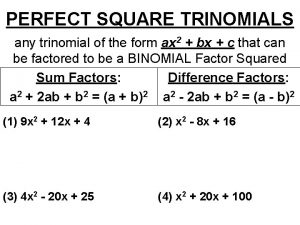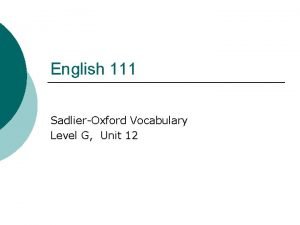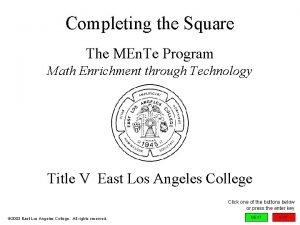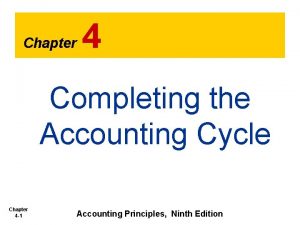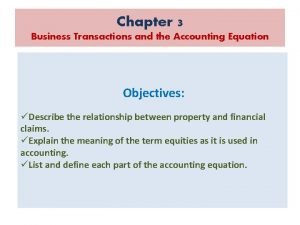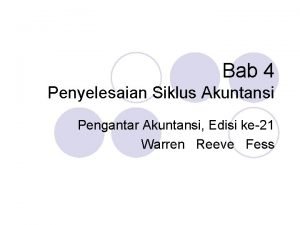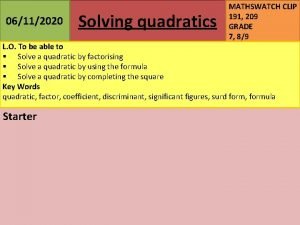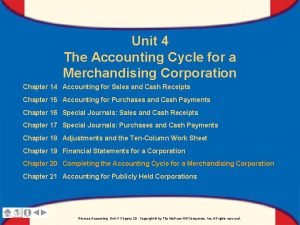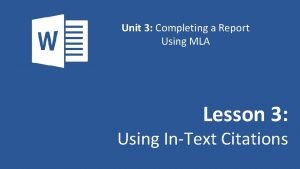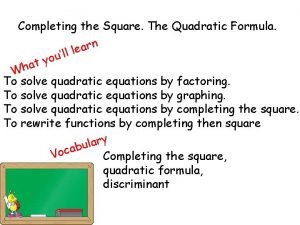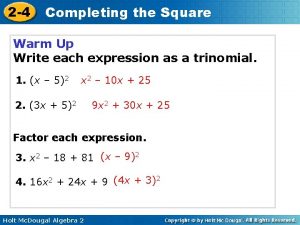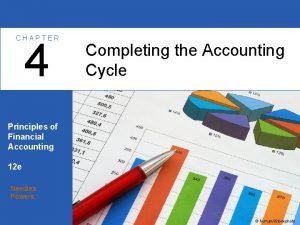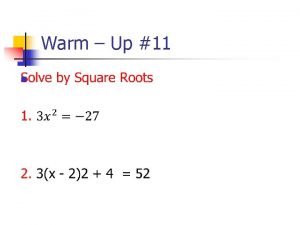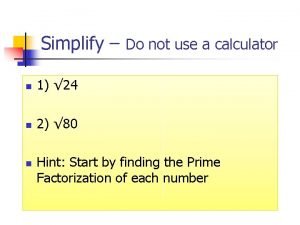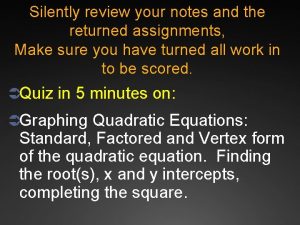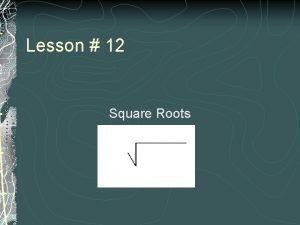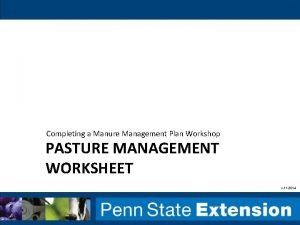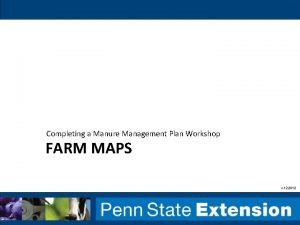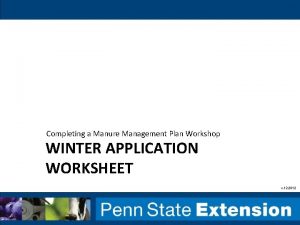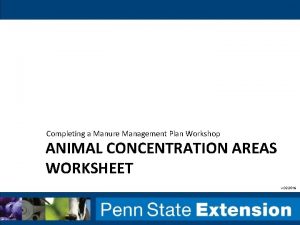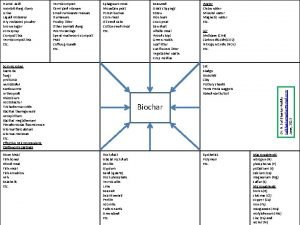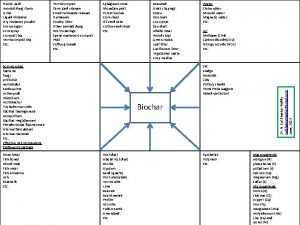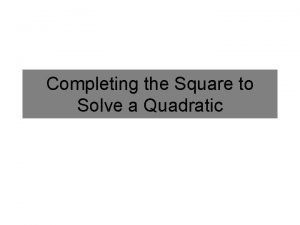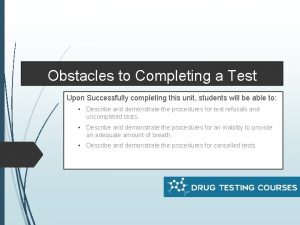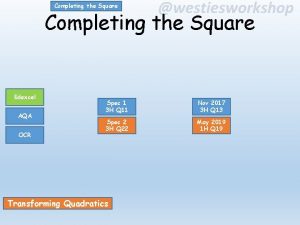Completing a Manure Management Plan Workshop MANURE MANAGEMENT



































































- Slides: 67

Completing a Manure Management Plan Workshop MANURE MANAGEMENT PLAN SUMMARY – MMP NBS v. 01. 2019

Nutrient Balance Sheets • Nutrient Balance Sheets may be used instead of the Manure Application Rate Tables • Farm and crop specific – Better utilize manure to meet crop nutrient needs – Reduces need to purchase fertilizer • Nutrient Balance Sheets – Act 38 Nutrient Balance Sheets • Paper or Excel spreadsheet versions • Nutrient Balance Worksheet User Guide – MMP Nutrient Balance Sheets • Paper version • MMP Nutrient Balance Worksheet User Guide • Excel version

Manure Management Plan Nutrient Balance Worksheet Purpose of the worksheet is to calculate a planned manure rate for a specific crop management scenario. Planned Manure Rate

Crop Management Scenarios • Management scenarios are created by different combinations of: – – – Planning Basis (Nitrogen or Phosphorus) Crop Groups (and Yields) Manure Groups Application Seasons Incorporation Timing

Manure Management Plan Summary Planned Application Rate from C, NBS, PI * (d) Crop Group and Yield (a) Manure Group (b) Application Season (c ) Incorporation Timing (e) Corn Silage (23 T/A) Liquid Dairy Spring No lncorporation Corn Silage (23 T/A) Liquid Dairy Spring Inc. < 1 Week Corn Silage (23 T/A) Liquid Dairy Fall No lncorporation Corn Silage (23 T/A) Solid Dairy Spring No lncorporation Corn Silage (23 T/A) Solid Dairy Fall No lncorporation Corn Silage (23 T/A) Solid Dairy Winter Cover Crop Corn Silage After Alfalfa (23 T/A) Liquid Dairy Spring Inc. < 1 Week Grass Hay (4 T/A) Liquid Dairy Summer No lncorporation Commercial Fertilizer Application Rate (f) Fields where this crop group can be used (g)

Crop Management Scenarios • Management scenarios are created by different combinations of: – Planning Basis • P Removal • N Based – Crop Groups (and Yields) • Crop Harvest (e. g. corn silage vs. corn grain) • Crop Rotation (e. g. corn after legume vs. corn after non-legume) – Manure Groups • Different storage locations • Different seasons or times of application – Application Seasons • Spring or Summer • Early Fall • Late Fall or Winter – Incorporation Timing • Incorporated (and how soon after application) vs. not incorporated

Determining Planning Basis • Option 1 – P Removal – Manure application rates based on crop removal of phosphorus • Planning requirements – No soil tests required – Fields with soil tests greater than 200 ppm P • Management considerations – P removal based manure rates are lower than N rates • Generally less than one-half – Will most likely require supplemental N fertilizer • Option 2 – N Based – Manure application rates based on net nitrogen requirement • Planning requirements – Soil tests required – Only fields with soil tests less than 200 ppm P • Management considerations – Maximum manure application rates can be applied – N requirement based manure rates will most likely apply excess phosphorus

Determining Crop Groups • Step 1 – Make a list of all the crops grown on the operation • Example: – – Corn Soybeans Barley Alfalfa • Step 2 – Make the list more specific if a crop is harvested differently • Example: – – – Corn Grain Corn Silage Soybeans Barley Alfalfa

Determining Crop Groups • Step 3 – Make the list more specific for crops that follow a legume in the rotation • Example: – – – – – Corn Grain After Soybeans Corn Grain After Alfalfa Corn Silage After Soybeans Corn Silage After Alfalfa Soybeans Barley Alfalfa • Step 4 – Eliminate crops from the list that do not receive manure • Example: – – – Corn Grain After Soybeans Corn Grain After Alfalfa Corn Silage After Soybeans Corn Silage After Alfalfa

Determining Crop Groups • Step 5 – Make the list more specific if certain crops have different yields • Example: – – – – Corn Grain 150 bu/A Corn Grain 200 bu/A Corn Grain After Soybeans Corn Grain After Alfalfa Corn Silage After Soybeans Corn Silage After Alfalfa • Crop groups – Not tied to a field or crop year • Options 1 and 2 can use the “crop group” approach – Will be valid for a number of crop years • Until there is some change – Include all the fields that will have that crop over the crop rotation • Option 3 requires the P Index – The planning basis must be annual and “field by field” – Must be prepared by an “authorized” specialist • P Index training

Determining Manure Groups • Manure groups are different kinds of manure applied to fields – To determine manure groups on the operation answer two questions • Question #1: Where do you physically get the manure to load in the spreader? – Each location is usually a different manure group – Examples: storage tank, box stalls, stacking pad, broiler house • Question #2: When (season) do you load manure in the spreader from this location? – Different season means different manure groups • Give the manure groups names that mean something to you – Including the season in name is helpful in planning and implementing the plan – Examples : Pit Spring, Heifer Barn Fall, Stack Pad Spring

Determining Application Seasons • Important aspect of manure application management – Determines how much nitrogen will be available to the crop • Two parts to this determination – Previously began this determination when identifying manure groups • When is the manure in a storage location land applied? – Which crops will a manure group be applied to? • Example: liquid manure on grass hay but not solid manure • Use Table 7 in Nutrient Balance Worksheet User Guide – First column: Planned manure application season • Typical application seasons – Spring or summer – Early Fall • Different options for double crops and use of cover crops – Late Fall or Winter

Determining Incorporation Timing • Second important aspect of manure application management – Determines how much nitrogen will be available to the crop • Use Table 7 in Nutrient Balance Worksheet User Guide – Second and third columns • Planned manure target crop utilization • Application management • Typical management options – – Manure incorporation up to 7 days Incorporation after 7 days or no incorporation No cover crop Cover crop • Cover crop harvested for silage • Cover crop used as green manure • This will provide a “Nitrogen availability factor” – Used in the worksheet – row H

Manure Management Plan Exercise – Page 6 Complete 4 “Crop Management Scenario” Columns

Manure Management Plan Summary Planned Application Rate from C, NBS, PI * (d) Crop Group and Yield (a) Manure Group (b) Application Season (c ) Corn Silage (23 T/A) Liquid Dairy Spring No lncorporation Corn Silage After Alfalfa (23 T/A) Liquid Dairy Spring Inc. < 1 Week Grass Hay (4 T/A) Liquid Dairy Summer No lncorporation Corn Silage (23 T/A) Liquid Dairy Spring Inc. < 1 Week Corn Silage (23 T/A) Liquid Dairy Fall No lncorporation Corn Silage (23 T/A) Solid Dairy Spring No lncorporation Corn Silage (23 T/A) Solid Dairy Fall No lncorporation Corn Silage (23“crop T/A) Each Incorporation Timing (e) Commercial Fertilizer Application Rate (f) Fields where this crop group can be used (g) Cover Crop Solid Dairy Winter management scenario”: • Requires the completion of a separate MMP Nutrient Balance Worksheet.

MMP Nutrient Balance Worksheet • Complete top section of the MMP NBS – Include all the fields that will have this “crop management scenario” over the crop rotation Corn Silage after Alfalfa 23 T/A All Fields X Liquid Dairy Spring Incorporated 5 -7 days

MMP Nutrient Balance Worksheet Exercise Complete Top Section of MMP NBS

Crop Nutrient Requirements • Basis for determining a planned manure rate – Net crop requirement for either nitrogen or phosphorus removal • How is “net crop requirement” determined? – Start with base recommendation • Soil test recommendations or crop removal – Need to account for other known sources of nutrients • Subtracted from recommendation or removal amounts • Four primary adjustments (or reductions) – Fertilizer Applied • Regardless of manure: starter, herbicide carrier, etc. – Other Organic Sources Applied • Other manure, biosolids – Residual Manure N • From previous manure applications – Residual Legume N • From previous year’s legume crop • Recommendations – Adjustments = Net Crop Requirement

Manure Management Plan Nutrient Balance Worksheet Nutrient Requirement Note which columns are required: • N – all options • P 2 O 5 – optional for N based rates • K 2 O – optional for all rates

Nutrient Balance Sheet Example Scenario • Planned crop – Corn for Silage – 23 ton/A expected yield • Starter Fertilizer – 100 lb/A 10 -10 -10 • Other manure to be applied – None • Manure history – Lactating dairy cow manure applied ~3 / 5 yrs • Crop Rotation – Following Alfalfa, 25 -50% stand, moderate productivity soil

N A) Recommendation or Removal (lb/A) Recommendation or Removal • Soil test report recommendations – Preferred B) Fertilizer Applied (lb/A) C) Other Organic Sources Applied (lb/A) D) Residual Manure N (lb/A) E) Previous Legume N (lb/A) F) Net Nutrient Requirement (lb/A) (A – B – C – D – E) G) Manure Nutrient Content (lb/ton or lb/1000 gal) • Nitrogen Removal – NBS Tables 1 or 2 H) Nitrogen Availability Factor I) Available Nitrogen (lb/ton or lb/1000 gal) (G x H) • P 2 O 5 & K 2 O Removal – NBS Table 3 J) Balanced Manure Rate (tons/A or gallons/A) For N: (F I) For P: (F G) K) Planned Manure Rate (tons/A or gallons/A) L) Nutrients Applied at Planned Rate (lb/A) For N: (K x I) For P & K: (K x G) M) Nutrient Balance at Planned Rate (lb/A) (F - L) (Indicate short or excess) P 2 O 5 K 2 O

Soil Test Report Recommendations • Nitrogen – 160 lb N/A • P 2 O 5 – 30 lb P 2 O 5/A • K 2 O – 0 lb K 2 O/A

N A) Recommendation or Removal (lb/A) Recommendation B) Fertilizer Applied (lb/A) C) Other Organic Sources Applied (lb/A) • Nitrogen • 160 lb N/A D) Residual Manure N (lb/A) E) Previous Legume N (lb/A) F) Net Nutrient Requirement (lb/A) (A – B – C – D – E) • P 2 O 5 • 30 lb P 2 O 5/A • K 2 O • 0 lb K 2 O/A G) Manure Nutrient Content (lb/ton or lb/1000 gal) H) Nitrogen Availability Factor I) Available Nitrogen (lb/ton or lb/1000 gal) (G x H) J) Balanced Manure Rate (tons/A or gallons/A) For N: (F I) For P: (F G) K) Planned Manure Rate (tons/A or gallons/A) L) Nutrients Applied at Planned Rate (lb/A) For N: (K x I) For P & K: (K x G) M) Nutrient Balance at Planned Rate (lb/A) (F - L) (Indicate short or excess) 160 P 2 O 5 K 2 O 30 0

Determining Nitrogen Recommendation NBS Table 1 (Agronomy Guide Table 1. 2 -5)

Determining Nitrogen Removal NBS Table 2 (Agronomy Guide Table 1. 2 -7) • Legume crops do not require nitrogen fertilizer – Soil test recommendations are “ 0” – No value from the manure N • Manure can be applied to legumes – Based on N removal by the legume crop

Determining P & K Removal NBS Table 3 (Agronomy Guide Table 1. 2 -8) Per unit of yield Crop (units) P 2 O 5 K 2 O Corn (bu) 0. 4 0. 3 Corn silage (T)1 4. 0 Grain sorghum (bu) Typical yield/A Removal for given yield P 2 O 5 K 2 O 150 (bu) 60 45 8. 0 25 (T) 100 200 0. 6 0. 8 125 (bu) 75 100 Forage sorghum (T)1 3. 0 10. 0 15 (T) 45 150 Sorghum/sudangrass 1 7. 0 15 (T) 105 Alfalfa (T)2, 3 15. 0 50. 0 5 (T) 75 250 Red clover (T)2, 3 15. 0 40. 0 3. 5 (T) 55 140 Trefoil (T)2, 3 15. 0 40. 0 3. 5 (T) 55 140 Cool-season grass (T)2, 3 15. 0 50. 0 4 (T) 60 200 Bluegrass (T)2, 3 10. 0 30. 0 2. 5 (T) 25 75 Wheat/rye (bu)4 1. 0 1. 8 60 (bu) 60 110 Oats (bu)4 0. 9 1. 5 80 (bu) 70 120 Barley (bu)4 0. 6 1. 5 75 (bu) 45 110 Soybeans (bu) 1. 0 1. 4 50 (bu) 50 70 Small grain silage (T)1 7. 0 26. 0 6 (T) 40 160

A) Recommendation or Removal (lb/A) Crop Removal Yield x removal/unit yield • Nitrogen – 23 t/A x 7 lb N/ton = • 161 lb N/A B) Fertilizer Applied (lb/A) C) Other Organic Sources Applied (lb/A) D) Residual Manure N (lb/A) E) Previous Legume N (lb/A) F) Net Nutrient Requirement (lb/A) (A – B – C – D – E) • P 2 O 5 – 23 t/A x 4 lb P 2 O 5/ton = • 92 lb P 2 O 5/A G) Manure Nutrient Content (lb/ton or lb/1000 gal) H) Nitrogen Availability Factor I) Available Nitrogen (lb/ton or lb/1000 gal) (G x H) J) Balanced Manure Rate (tons/A or gallons/A) • K 2 O For N: (F I) – 23 t/A x 8 lb K 2 O/ton = • 184 lb K 2 O/A For P: (F G) K) Planned Manure Rate (tons/A or gallons/A) L) Nutrients Applied at Planned Rate (lb/A) For N: (K x I) For P & K: (K x G) M) Nutrient Balance at Planned Rate (lb/A) (F - L) (Indicate short or excess) N P 2 O 5 K 2 O 161 92 184

A) Recommendation or Removal (lb/A) Fertilizer Applied B) Fertilizer Applied (lb/A) C) Other Organic Sources Applied (lb/A) • Fertilizer nutrients to be applied regardless of manure – Starter – Herbicide carrier – Other • Other organic nutrients applied – Other manure application – Imported biosolids – Other D) Residual Manure N (lb/A) E) Previous Legume N (lb/A) F) Net Nutrient Requirement (lb/A) (A – B – C – D – E) G) Manure Nutrient Content (lb/ton or lb/1000 gal) H) Nitrogen Availability Factor I) Available Nitrogen (lb/ton or lb/1000 gal) (G x H) J) Balanced Manure Rate (tons/A or gallons/A) For N: (F I) For P: (F G) K) Planned Manure Rate (tons/A or gallons/A) L) Nutrients Applied at Planned Rate (lb/A) For N: (K x I) For P & K: (K x G) M) Nutrient Balance at Planned Rate (lb/A) (F - L) (Indicate short or excess) N P 2 O 5 K 2 O 160 30 0

A) Recommendation or Removal (lb/A) Fertilizer Applied B) Fertilizer Applied (lb/A) C) Other Organic Sources Applied (lb/A) • Starter D) Residual Manure N (lb/A) E) Previous Legume N (lb/A) • 100 lb/A 10 - 10 – N: 100 lb/A x 0. 10 = • 10 lb N/A F) Net Nutrient Requirement (lb/A) (A – B – C – D – E) G) Manure Nutrient Content (lb/ton or lb/1000 gal) H) Nitrogen Availability Factor – P: 100 lb/A x 0. 10 = • 10 lb P 2 O 5/A I) Available Nitrogen (lb/ton or lb/1000 gal) (G x H) J) Balanced Manure Rate (tons/A or gallons/A) For N: (F I) – K: 100 lb/A x 0. 10 = • 10 lb K 2 O/A For P: (F G) K) Planned Manure Rate (tons/A or gallons/A) L) Nutrients Applied at Planned Rate (lb/A) For N: (K x I) For P & K: (K x G) M) Nutrient Balance at Planned Rate (lb/A) (F - L) (Indicate short or excess) N P 2 O 5 K 2 O 160 30 0 10 10 10

A) Recommendation or Removal (lb/A) Other Organic Sources Applied B) Fertilizer Applied (lb/A) C) Other Organic Sources Applied (lb/A) • Multiple applications on a field – Enter “Nutrients applied at Planned Rate “ (Row L) from other application into “Other organic sources” (Row C) for this application • None in this example N P 2 O 5 K 2 O 160 30 0 10 10 10 - - - D) Residual Manure N (lb/A) E) Previous Legume N (lb/A) F) Net Nutrient Requirement (lb/A) (A – B – C – D – E) Transfer this from L in other G) Manure Nutrientapplication Content (lb/ton or lb/1000 gal) NBS. H) Nitrogen Availability Factor I) Available Nitrogen (lb/ton or lb/1000 gal) (G x H) J) Balanced Manure Rate (tons/A or gallons/A) For N: (F I) For P: (F G) K) Planned Manure Rate (tons/A or gallons/A) L) Nutrients Applied at Planned Rate (lb/A) For N: (K x I) For P & K: (K x G) M) Nutrient Balance at Planned Rate (lb/A) (F - L) (Indicate short or excess)

A) Recommendation or Removal (lb/A) Residual Manure N N accumulated in the soil from previous manure applications Total N Soluble Mineral N Readily available similar to urea fertilizer. Susceptible to volatilization. Organic N B) Fertilizer Applied (lb/A) C) Other Organic Sources Applied (lb/A) D) Residual Manure N (lb/A) E) Previous Legume N (lb/A) F) Net Nutrient Requirement (lb/A) (A – B – C – D – E) G) Manure Nutrient Content (lb/ton or lb/1000 gal) H) Nitrogen Availability Factor I) Available Nitrogen (lb/ton or lb/1000 gal) Organic N Must be broken down into mineral forms before it is available. Releases over a period of years. (G x H) J) Balanced Manure Rate (tons/A or gallons/A) For N: (F I) For P: (F G) K) Planned Manure Rate (tons/A or gallons/A) L) Nutrients Applied at Planned Rate (lb/A) For N: (K x I) For P & K: (K x G) M) Nutrient Balance at Planned Rate (lb/A) (F - L) (Indicate short or excess) N P 2 O 5 K 2 O 160 30 0 10 10 10 - - -

Residual N Previous Manure Applications Table 4 (Agronomy Guide Table 1. 2 -14 B)

A) Recommendation or Removal (lb/A) Residual Manure N B) Fertilizer Applied (lb/A) C) Other Organic Sources Applied (lb/A) • Manure history – – Dairy manure Applied ~3 / 5 yrs Frequent 20 lb N/A D) Residual Manure N (lb/A) E) Previous Legume N (lb/A) F) Net Nutrient Requirement (lb/A) (A – B – C – D – E) G) Manure Nutrient Content (lb/ton or lb/1000 gal) H) Nitrogen Availability Factor I) Available Nitrogen (lb/ton or lb/1000 gal) (G x H) J) Balanced Manure Rate (tons/A or gallons/A) For N: (F I) For P: (F G) K) Planned Manure Rate (tons/A or gallons/A) L) Nutrients Applied at Planned Rate (lb/A) For N: (K x I) For P & K: (K x G) M) Nutrient Balance at Planned Rate (lb/A) (F - L) (Indicate short or excess) N P 2 O 5 K 2 O 160 30 0 10 10 10 - - - 20

A) Recommendation or Removal (lb/A) Previous Legume N B) Fertilizer Applied (lb/A) C) Other Organic Sources Applied (lb/A) • Properly inoculated legumes meet their N requirement by fixing atmospheric N • Significant N remains in residue from legume when crops are rotated • Adjust following crop N requirement for legume N contribution D) Residual Manure N (lb/A) E) Previous Legume N (lb/A) F) Net Nutrient Requirement (lb/A) (A – B – C – D – E) G) Manure Nutrient Content (lb/ton or lb/1000 gal) H) Nitrogen Availability Factor I) Available Nitrogen (lb/ton or lb/1000 gal) (G x H) J) Balanced Manure Rate (tons/A or gallons/A) For N: (F I) For P: (F G) K) Planned Manure Rate (tons/A or gallons/A) L) Nutrients Applied at Planned Rate (lb/A) For N: (K x I) For P & K: (K x G) M) Nutrient Balance at Planned Rate (lb/A) (F - L) (Indicate short or excess) N P 2 O 5 K 2 O 160 30 0 10 10 10 - - - 20

Residual N Previous Legume Crops NBS Table 5 (Agronomy Guide Table 1. 2 -6)

Previous Legume • Also on PSU soil test report if the previous crop is entered as a legume

A) Recommendation or Removal (lb/A) Previous Legume N • Previous Alfalfa • 20 -50% Stand • Moderate Productivity Soil B) Fertilizer Applied (lb/A) C) Other Organic Sources Applied (lb/A) P 2 O 5 K 2 O 160 30 0 10 10 10 - - - D) Residual Manure N (lb/A) 20 E) Previous Legume N (lb/A) 70 F) Net Nutrient Requirement (lb/A) (A – B – C – D – E) G) Manure Nutrient Content (lb/ton or lb/1000 gal) H) Nitrogen Availability Factor I) Available Nitrogen (lb/ton or lb/1000 gal) • 70 lb N/A N (G x H) J) Balanced Manure Rate (tons/A or gallons/A) For N: (F I) For P: (F G) K) Planned Manure Rate (tons/A or gallons/A) L) Nutrients Applied at Planned Rate (lb/A) For N: (K x I) For P & K: (K x G) M) Nutrient Balance at Planned Rate (lb/A) (F - L) (Indicate short or excess)

A) Recommendation or Removal (lb/A) Net Nutrient Requirement • Recommendation or removal • Subtract – Fertilizer applied – Other organic sources applied – Residual manure N – Residual legume N • = Net Nutrient Requirement Note: Include excesses – 10 lb excess K 2 O/A B) Fertilizer Applied (lb/A) C) Other Organic Sources Applied (lb/A) N P 2 O 5 K 2 O 160 30 0 10 10 10 - - - 20 (10) D) Residual Manure N (lb/A) 20 E) Previous Legume N (lb/A) 70 F) Net Nutrient Requirement (lb/A) (A – B – C – D – E) G) Manure Nutrient Content (lb/ton or lb/1000 gal) H) Nitrogen Availability Factor I) Available Nitrogen (lb/ton or lb/1000 gal) (G x H) J) Balanced Manure Rate (tons/A or gallons/A) For N: (F I) For P: (F G) K) Planned Manure Rate (tons/A or gallons/A) L) Nutrients Applied at Planned Rate (lb/A) For N: (K x I) For P & K: (K x G) M) Nutrient Balance at Planned Rate (lb/A) (F - L) (Indicate short or excess) 60

MMP Nutrient Balance Worksheet Exercise Complete Nutrient Balance Worksheet – Rows A - F

N-Based Balanced Manure Rate • Rate or amount of manure applied to a crop field where: – available manure N equals – net crop N requirement

A) Recommendation or Removal (lb/A) Manure Nutrient Content • Manure Analysis Report (Preferred) B) Fertilizer Applied (lb/A) C) Other Organic Sources Applied (lb/A) P 2 O 5 K 2 O 160 30 0 10 10 10 - - - 20 (10) D) Residual Manure N (lb/A) 20 E) Previous Legume N (lb/A) 70 F) Net Nutrient Requirement (lb/A) (A – B – C – D – E) G) Manure Nutrient Content (lb/ton or lb/1000 gal) • NBS Table 6 N H) Nitrogen Availability Factor I) Available Nitrogen (lb/ton or lb/1000 gal) (G x H) J) Balanced Manure Rate (tons/A or gallons/A) For N: (F I) For P: (F G) K) Planned Manure Rate (tons/A or gallons/A) L) Nutrients Applied at Planned Rate (lb/A) For N: (K x I) For P & K: (K x G) M) Nutrient Balance at Planned Rate (lb/A) (F - L) (Indicate short or excess) 60

Manure Analysis Report • Manure analysis is the most reliable estimation of manure nutrient content • Use lb/ton if manure is spread as ton/A • Use lb/1000 gal if manure is spread as gallons/A

Manure Nutrient Content Table 6 (Agronomy Guide Table 1. 2 -13)

A) Recommendation or Removal (lb/A) Manure Nutrient Content • Lactating dairy cows – Liquid • Manure Analysis – From manure analysis • Book values – 28 lb N/1000 gal – 13 lb P 2 O 5/1000 gal – 25 lb K 2 O/1000 gal B) Fertilizer Applied (lb/A) C) Other Organic Sources Applied (lb/A) N P 2 O 5 K 2 O 160 30 0 10 10 10 - - - 60 20 (10) 27 12 23 D) Residual Manure N (lb/A) 20 E) Previous Legume N (lb/A) 70 F) Net Nutrient Requirement (lb/A) (A – B – C – D – E) G) Manure Nutrient Content (lb/ton or lb/1000 gal) H) Nitrogen Availability Factor I) Available Nitrogen (lb/ton or lb/1000 gal) (G x H) J) Balanced Manure Rate (tons/A or gallons/A) For N: (F I) For P: (F G) K) Planned Manure Rate (tons/A or gallons/A) L) Nutrients Applied at Planned Rate (lb/A) For N: (K x I) For P & K: (K x G) M) Nutrient Balance at Planned Rate (lb/A) (F - L) (Indicate short or excess)

MMP Nutrient Balance Worksheet Exercise Complete Nutrient Balance Worksheet – Row G

Nitrogen Fractions in Manure • Only a percentage of manure N is available to the crop in the year that it applied • Two factors determine this amount – Type of manure • Ratio ammonium N and organic N – Application management • How quickly the manure is incorporated Total Manure N Soluble Mineral N Organic N Readily available similar to urea fertilizer. Susceptible to volatilization. Must be broken down into mineral forms before it is available. Releases over a period of years.

A) Recommendation or Removal (lb/A) Nitrogen Availability Factor • NBS Table 7 B) Fertilizer Applied (lb/A) C) Other Organic Sources Applied (lb/A) N P 2 O 5 K 2 O 160 30 0 10 10 10 - - - 60 20 (10) 27 12 23 D) Residual Manure N (lb/A) 20 E) Previous Legume N (lb/A) 70 F) Net Nutrient Requirement (lb/A) (A – B – C – D – E) G) Manure Nutrient Content (lb/ton or lb/1000 gal) H) Nitrogen Availability Factor I) Available Nitrogen (lb/ton or lb/1000 gal) (G x H) J) Balanced Manure Rate (tons/A or gallons/A) For N: (F I) For P: (F G) K) Planned Manure Rate (tons/A or gallons/A) L) Nutrients Applied at Planned Rate (lb/A) For N: (K x I) For P & K: (K x G) M) Nutrient Balance at Planned Rate (lb/A) (F - L) (Indicate short or excess)

Manure Nitrogen Availability Table 7 (Agronomy Guide Table 1. 2 -14 A)

N P 2 O 5 K 2 O 160 30 0 10 10 10 - - - 60 20 (10) G) Manure Nutrient Content (lb/ton or lb/1000 gal) 27 12 23 H) Nitrogen Availability Factor . 30 A) Recommendation or Removal (lb/A) Nitrogen Availability Factor • NBS Table 7 • Manure is: – Spring applied – For corn crop – Incorporated 5 -7 days – Dairy manure B) Fertilizer Applied (lb/A) C) Other Organic Sources Applied (lb/A) D) Residual Manure N (lb/A) 20 E) Previous Legume N (lb/A) 70 F) Net Nutrient Requirement (lb/A) (A – B – C – D – E) I) Available Nitrogen (lb/ton or lb/1000 gal) (G x H) J) Balanced Manure Rate (tons/A or gallons/A) • Nitrogen availability factor –. 30 For N: (F I) For P: (F G) K) Planned Manure Rate (tons/A or gallons/A) L) Nutrients Applied at Planned Rate (lb/A) For N: (K x I) For P & K: (K x G) M) Nutrient Balance at Planned Rate (lb/A) (F - L) (Indicate short or excess)

N P 2 O 5 K 2 O 160 30 0 10 10 10 - - - 60 20 (10) G) Manure Nutrient Content (lb/ton or lb/1000 gal) 27 12 23 H) Nitrogen Availability Factor . 30 A) Recommendation or Removal (lb/A) Available Nitrogen B) Fertilizer Applied (lb/A) C) Other Organic Sources Applied (lb/A) • Available N = – Manure N Analysis x Availability Factor • Available N – 27 lb N/1000 gal x. 30 = – 8. 1 lb Available N/1000 gal D) Residual Manure N (lb/A) 20 E) Previous Legume N (lb/A) 70 F) Net Nutrient Requirement (lb/A) (A – B – C – D – E) I) Available Nitrogen (lb/ton or lb/1000 gal) (G x H) J) Balanced Manure Rate (tons/A or gallons/A) For N: (F I) For P: (F G) K) Planned Manure Rate (tons/A or gallons/A) L) Nutrients Applied at Planned Rate (lb/A) For N: (K x I) For P & K: (K x G) M) Nutrient Balance at Planned Rate (lb/A) (F - L) (Indicate short or excess) 8. 1

MMP Nutrient Balance Worksheet Exercise Complete Nutrient Balance Worksheet – Rows H - I

N P 2 O 5 K 2 O 160 30 0 10 10 10 - - - 60 20 (10) G) Manure Nutrient Content (lb/ton or lb/1000 gal) 27 12 23 H) Nitrogen Availability Factor . 30 A) Recommendation or Removal (lb/A) Balanced Manure Rate • Balanced manure rate = – Net N Requirement ÷ Available N • Balanced N manure rate – 60 lb/A ÷ 8. 1 lb Avail. N/1000 gal = – 7407 gallons/A B) Fertilizer Applied (lb/A) C) Other Organic Sources Applied (lb/A) D) Residual Manure N (lb/A) 20 E) Previous Legume N (lb/A) 70 F) Net Nutrient Requirement (lb/A) (A – B – C – D – E) I) Available Nitrogen (lb/ton or lb/1000 gal) (G x H) J) Balanced Manure Rate (tons/A or gallons/A) For N: (F I) For P: (F G) K) Planned Manure Rate (tons/A or gallons/A) L) Nutrients Applied at Planned Rate (lb/A) For N: (K x I) For P & K: (K x G) M) Nutrient Balance at Planned Rate (lb/A) (F - L) (Indicate short or excess) 8. 1 7407

P-Removal Based Balanced Manure Rate • Rate or amount of manure applied to a crop field where: – Available manure P 2 O 5 equals – Net crop P 2 O 5 requirement

N P 2 O 5 K 2 O 160 92 184 10 10 10 - - - 60 82 174 G) Manure Nutrient Content (lb/ton or lb/1000 gal) 27 12 23 H) Nitrogen Availability Factor . 30 A) Recommendation or Removal (lb/A) P Removal Balanced Manure Rate • Balanced manure rate = – Net P 2 O 5 Requirement ÷ Manure P 2 O 5 • P removal balanced manure rate – 82 lb/A ÷ 12 lb P 2 O 5 /1000 gal = – 6833 gallons/A B) Fertilizer Applied (lb/A) C) Other Organic Sources Applied (lb/A) D) Residual Manure N (lb/A) 20 E) Previous Legume N (lb/A) 70 F) Net Nutrient Requirement (lb/A) (A – B – C – D – E) I) Available Nitrogen (lb/ton or lb/1000 gal) (G x H) J) Balanced Manure Rate (tons/A or gallons/A) For N: (F I) For P: (F G) K) Planned Manure Rate (tons/A or gallons/A) L) Nutrients Applied at Planned Rate (lb/A) For N: (K x I) For P & K: (K x G) M) Nutrient Balance at Planned Rate (lb/A) (F - L) (Indicate short or excess) 8. 1 7407 6833

MMP Nutrient Balance Worksheet Exercise Complete Nutrient Balance Worksheet – Row J

N P 2 O 5 K 2 O 160 30 0 10 10 10 - - - 60 20 (10) G) Manure Nutrient Content (lb/ton or lb/1000 gal) 27 12 23 H) Nitrogen Availability Factor . 30 A) Recommendation or Removal (lb/A) Planned Manure Rate – N-Based • Must be less than or equal to the N balanced rate B) Fertilizer Applied (lb/A) C) Other Organic Sources Applied (lb/A) D) Residual Manure N (lb/A) 20 E) Previous Legume N (lb/A) 70 F) Net Nutrient Requirement (lb/A) (A – B – C – D – E) I) Available Nitrogen (lb/ton or lb/1000 gal) (G x H) J) Balanced Manure Rate (tons/A or gallons/A) For N: (F I) For P: (F G) K) Planned Manure Rate (tons/A or gallons/A) L) Nutrients Applied at Planned Rate (lb/A) For N: (K x I) For P & K: (K x G) M) Nutrient Balance at Planned Rate (lb/A) (F - L) (Indicate short or excess) 8. 1 7407

Practical Application Rates • Planned manure rates must be realistic and achievable • Selected planned manure rates are determined by manure spreader calibration • Agronomy Facts 68: Manure Spreader Calibration

N P 2 O 5 K 2 O 160 30 0 10 10 10 - - - 60 20 (10) G) Manure Nutrient Content (lb/ton or lb/1000 gal) 27 12 23 H) Nitrogen Availability Factor . 30 A) Recommendation or Removal (lb/A) Planned Manure Rate – N-Based B) Fertilizer Applied (lb/A) C) Other Organic Sources Applied (lb/A) • Calibrated rates D) Residual Manure N (lb/A) 20 – 9000 gallons/A – 4000 gallons/A E) Previous Legume N (lb/A) 70 F) Net Nutrient Requirement (lb/A) (A – B – C – D – E) I) Available Nitrogen (lb/ton or lb/1000 gal) (G x H) J) Balanced Manure Rate (tons/A or gallons/A) For N: (F I) For P: (F G) K) Planned Manure Rate (tons/A or gallons/A) L) Nutrients Applied at Planned Rate (lb/A) For N: (K x I) For P & K: (K x G) M) Nutrient Balance at Planned Rate (lb/A) (F - L) (Indicate short or excess) 8. 1 7407 4000

N P 2 O 5 K 2 O 160 92 184 10 10 10 - - - 60 82 174 G) Manure Nutrient Content (lb/ton or lb/1000 gal) 27 12 23 H) Nitrogen Availability Factor . 30 A) Recommendation or Removal (lb/A) Planned Manure Rate – P-Removal • Must be less than or equal to the P-removal balanced rate • Calibrated rates – 9000 gallons/A – 4000 gallons/A • P-removal balanced rates are often very – Not able to achieve a practical planned rate B) Fertilizer Applied (lb/A) C) Other Organic Sources Applied (lb/A) D) Residual Manure N (lb/A) 20 E) Previous Legume N (lb/A) 70 F) Net Nutrient Requirement (lb/A) (A – B – C – D – E) I) Available Nitrogen (lb/ton or lb/1000 gal) (G x H) J) Balanced Manure Rate (tons/A or gallons/A) For N: (F I) • In those cases a soil test must be obtained – Use either Option 2 or 3 For P: (F G) K) Planned Manure Rate (tons/A or gallons/A) L) Nutrients Applied at Planned Rate (lb/A) For N: (K x I) For P & K: (K x G) M) Nutrient Balance at Planned Rate (lb/A) (F - L) (Indicate short or excess) 8. 1 6833 4000

MMP Nutrient Balance Worksheet Exercise Complete Nutrient Balance Worksheet – Row K

N P 2 O 5 K 2 O 160 30 0 10 10 10 - - - 60 20 (10) G) Manure Nutrient Content (lb/ton or lb/1000 gal) 27 12 23 H) Nitrogen Availability Factor . 30 A) Recommendation or Removal (lb/A) Nutrients Applied at N-Based Rate • Multiply planned rate by – Available manure N – P & K manure analysis • 4000 gal/A x – 8. 1 lb available N/1000 gal = 32 lb N/A – 12 lb P 2 O 5/1000 gal = 48 lb P 2 O 5/A – 23 lb K 2 O/1000 gal = 92 lb K 2 O/A B) Fertilizer Applied (lb/A) C) Other Organic Sources Applied (lb/A) D) Residual Manure N (lb/A) 20 E) Previous Legume N (lb/A) 70 F) Net Nutrient Requirement (lb/A) (A – B – C – D – E) I) Available Nitrogen (lb/ton or lb/1000 gal) (G x H) J) Balanced Manure Rate (tons/A or gallons/A) For N: (F I) For P: (F G) 8. 1 7407 4000 K) Planned Manure Rate (tons/A or gallons/A) L) Nutrients Applied at Planned Rate (lb/A) For N: (K x I) For P & K: (K x G) M) Nutrient Balance at Planned Rate (lb/A) (F - L) (Indicate short or excess) 32 48 92

N P 2 O 5 K 2 O 160 30 0 10 10 10 - - - 60 20 (10) G) Manure Nutrient Content (lb/ton or lb/1000 gal) 27 12 23 H) Nitrogen Availability Factor . 30 A) Recommendation or Removal (lb/A) Nutrient Balance at N-Based Rate • Subtract Manure Nutrients Applied at Planned Rate from Net Nutrient Requirement • Positive = nutrient deficit • Negative = excess nutrients – No excess N allowed by law B) Fertilizer Applied (lb/A) C) Other Organic Sources Applied (lb/A) D) Residual Manure N (lb/A) 20 E) Previous Legume N (lb/A) 70 F) Net Nutrient Requirement (lb/A) (A – B – C – D – E) I) Available Nitrogen (lb/ton or lb/1000 gal) (G x H) J) Balanced Manure Rate (tons/A or gallons/A) For N: (F I) For P: (F G) 8. 1 7407 4000 K) Planned Manure Rate (tons/A or gallons/A) L) Nutrients Applied at Planned Rate (lb/A) For N: (K x I) For P & K: (K x G) M) Nutrient Balance at Planned Rate (lb/A) (F - L) (Indicate short or excess) 32 48 92 28 (28) (102)

N P 2 O 5 K 2 O 160 92 184 10 10 10 - - - 60 82 174 G) Manure Nutrient Content (lb/ton or lb/1000 gal) 27 12 23 H) Nitrogen Availability Factor . 30 A) Recommendation or Removal (lb/A) Nutrient Balance at P-Removal Rate • P-removal rates will usually be short on N • Must calculate an N balance at the Premoval rate to know how much supplemental N is needed B) Fertilizer Applied (lb/A) C) Other Organic Sources Applied (lb/A) D) Residual Manure N (lb/A) 20 E) Previous Legume N (lb/A) 70 F) Net Nutrient Requirement (lb/A) (A – B – C – D – E) I) Available Nitrogen (lb/ton or lb/1000 gal) • P 2 O and K 2 O balances cannot be used to determine supplemental fertilizer needs (G x H) 8. 1 J) Balanced Manure Rate (tons/A or gallons/A) For N: (F I) 6833 For P: (F G) 4000 K) Planned Manure Rate (tons/A or gallons/A) L) Nutrients Applied at Planned Rate (lb/A) For N: (K x I) For P & K: (K x G) M) Nutrient Balance at Planned Rate (lb/A) (F - L) (Indicate short or excess) 32 48 92 28 34 82

Determining Additional Fertilizer • Refer to note between rows K and L • Use Row M nitrogen balance to determine N fertilizer needs • Row M P 2 O 5 and K 2 O balances can ONLY be used to determine additional P 2 O 5 and K 2 O fertilizer needs IF: – Soil test recommendations were used in Row A – Crop removal for P 2 O 5 and K 2 O only indicates what the crop will remove not what the levels are in the soil

MMP Nutrient Balance Worksheet Exercise Complete Nutrient Balance Worksheet – Rows L-M

Manure Management Plan Summary (p. 6) Crop Group and Yield (a) Manure Group (b) Application Season (c ) Planned Application Rate from C, NBS, PI * (d) Incorporation Timing (e) Corn Silage (23 T/A) Liquid Dairy Spring 9000 gal/A No lncorporation Corn Silage After Alfalfa (23 T/A) Liquid Dairy Spring 4000 gal/A Inc. < 1 Week Grass Hay (4 T/A) Liquid Dairy Summer 4000 gal/A No lncorporation Corn Silage (23 T/A) Solid Dairy Spring 25 ton/A No lncorporation Corn Silage (23 T/A) Liquid Dairy Fall 9000 gal/A No lncorporation Corn Silage (23 T/A) Solid Dairy Fall 25 ton/A No lncorporation Corn Silage (23 T/A) Solid Dairy Winter 25 ton/A Cover Crop Corn Silage (23 T/A) Liquid Dairy Spring 9000 gal/A Inc. < 1 Week Commercial Fertilizer Application Rate (f) Fields where this crop group can be used (g) 22 -0 -0 All fields

Manure Management Plan Exercise – Page 6 Complete 3 Remaining Columns
 Vocab unit 15 level g synonyms and antonyms
Vocab unit 15 level g synonyms and antonyms Definition of green manure
Definition of green manure Yasamin shirazi
Yasamin shirazi Puck manure
Puck manure Manure
Manure Bulky organic manure examples
Bulky organic manure examples Plant material manure and wood
Plant material manure and wood Business plan writing workshop
Business plan writing workshop Management plan in business plan
Management plan in business plan Workshop environmental management system
Workshop environmental management system Value management workshop agenda
Value management workshop agenda Vocab unit 11 level e
Vocab unit 11 level e Shading venn diagrams worksheet
Shading venn diagrams worksheet Completing sentences using picture clues
Completing sentences using picture clues How to use completing the square
How to use completing the square Site:slidetodoc.com
Site:slidetodoc.com Completing the square
Completing the square Perfect square formula
Perfect square formula 4-6 completing the square
4-6 completing the square Complete the square to write 16t2 - 96t
Complete the square to write 16t2 - 96t Complete the main idea by completing the paragraph
Complete the main idea by completing the paragraph Dr frost completing the square
Dr frost completing the square Verifying death geeky medics
Verifying death geeky medics Completing the square formula
Completing the square formula Complete the square conic sections
Complete the square conic sections Lesson 9-1 completing the square
Lesson 9-1 completing the square Closing entries sole proprietorship
Closing entries sole proprietorship Completing the square example
Completing the square example Completing reports and proposals
Completing reports and proposals What are the five basic objectives of a business message
What are the five basic objectives of a business message Test chapter 18 preparing for the world of work
Test chapter 18 preparing for the world of work Chapter 17:1 developing job keeping skills
Chapter 17:1 developing job keeping skills Writing and completing reports and proposals
Writing and completing reports and proposals Completing the square (continued) quiz
Completing the square (continued) quiz 9-5 completing the square
9-5 completing the square Lesson 8-8 practice b completing the square answers
Lesson 8-8 practice b completing the square answers 2-4 completing the square
2-4 completing the square 1/6 square root
1/6 square root Topic sentence örnekleri
Topic sentence örnekleri Perfect square in quadratic equation
Perfect square in quadratic equation Nat 5 parabolas
Nat 5 parabolas Completing the square formula
Completing the square formula Perfect binomial
Perfect binomial Dr frost maths completing the square
Dr frost maths completing the square Level g unit 12 synonyms
Level g unit 12 synonyms Completing square program
Completing square program Examples of complete and incomplete sentences
Examples of complete and incomplete sentences Completion of the accounting cycle
Completion of the accounting cycle Chapter 4 completing the accounting cycle
Chapter 4 completing the accounting cycle 3-11 completing the accounting equation
3-11 completing the accounting equation Completing the accounting cycle chapter 4 pdf
Completing the accounting cycle chapter 4 pdf Lesson 4-5 completing the square
Lesson 4-5 completing the square Completing the square (continued)
Completing the square (continued) Mathswatch completing the square answers
Mathswatch completing the square answers General ledger merchandising
General ledger merchandising Completing a report using mla quizlet
Completing a report using mla quizlet Time in spanish
Time in spanish Completing square method
Completing square method Creating a perfect square trinomial
Creating a perfect square trinomial Completion of the square
Completion of the square 2-4 completing the square
2-4 completing the square Completing the square
Completing the square Chapter 4 completing the accounting cycle
Chapter 4 completing the accounting cycle 9-8 completing the square
9-8 completing the square Completing the square
Completing the square Perfect square binomial calculator
Perfect square binomial calculator Complete the square equation
Complete the square equation Lesson-12
Lesson-12


